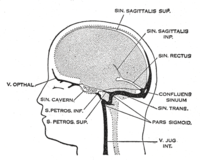
Photo from wikipedia
Evaluation of the hemodynamics in the portal venous system plays an essential role in many hepatic pathologies. Changes in portal flow and vessel morphology are often indicative of disease.Routinely used… Click to show full abstract
Evaluation of the hemodynamics in the portal venous system plays an essential role in many hepatic pathologies. Changes in portal flow and vessel morphology are often indicative of disease.Routinely used imaging modalities, such as CT, ultrasound, invasive angiography, and MRI, often focus on either hemodynamics or anatomical imaging. In contrast, 4D flow MRI facilitiates a more comprehensive understanding of pathophysiological mechanisms by simultaneously and noninvasively acquiring time-resolved flow and anatomical information in a 3D imaging volume. Though promising, 4D flow MRI in the portal venous system is especially challenging due to small vessel calibers, slow flow velocities, and breathing motion. In this review article, we will discuss how to account for these challenges when planning and conducting 4D flow MRI acquisitions in the upper abdomen. We will address patient preparation, sequence acquisition, postprocessing, quality control, and analysis of 4D flow data. In the second part of this article, we will review potential clinical applications of 4D flow MRI in the portal venous system. The most promising area for clinical utilization is the diagnosis and grading of liver cirrhosis and its complications. Relevant parameters acquired by 4D flow MRI include the detection of reduced or reversed flow in the portal venous system, characterization of portosystemic collaterals, and impaired response to a meal challenge. In patients with cirrhosis, 4D flow MRI has the potential to address the major unmet need of noninvasive detection of gastroesophageal varices at high risk for bleeding. This could replace many unnecessary, purely diagnostic, and invasive esophagogastroduodenoscopy procedures, thereby improving patient compliance with follow-up. Moreover, 4D flow MRI offers unique insights and added value for surgical planning and follow-up of multiple hepatic interventions, including transjugular intrahepatic portosystemic shunts, liver transplantation, and hepatic disease in children. Lastly, we will discuss the path to clinical implementation and remaining challenges.
Journal Title: Magnetic Resonance in Medical Sciences
Year Published: 2022
Link to full text (if available)
Share on Social Media: Sign Up to like & get
recommendations!